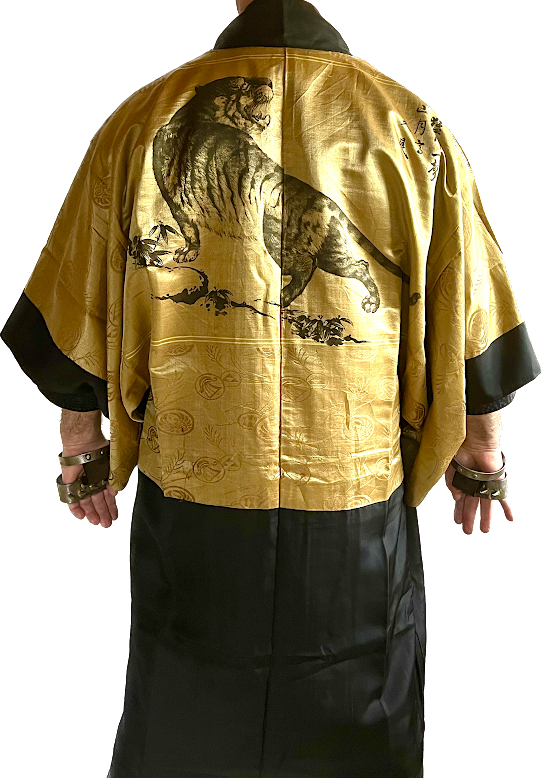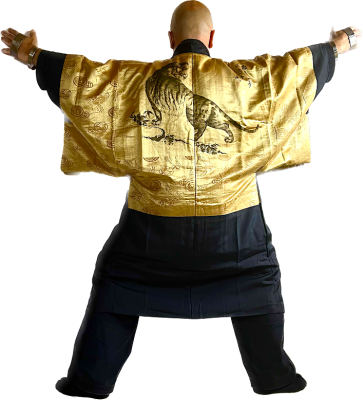
Men's Haori
- On 03/01/2023
- In Haori
- 0 comments
 All about the Men's Haori
All about the Men's Haori
The Haori word which comes from Japanese literally meaning feather weaving
(feather Ha 羽. Weaving Ori 織)
The Japanese haori is a short knee-length kimono jacket with wide sleeves (see the photo opposite) and is traditionally adorned according to the models of 2,3 or 5 family coat of arms or samurai clan called Mon 紋, Kamon 家紋 or Montsuki 紋付In accordance with Japanese tradition, originally haori is made of hemp, linen or thick silk taffeta of high quality "Habutae" weaving.
About the Men's Haori
All about the Men's Haori
 What is the Men's Japanese Haori ?
What is the Men's Japanese Haori ?
The Haori word which comes from Japanese literally meaning feather weaving
(feather Ha 羽. Weaving Ori 織)
The Japanese haori is a short knee-length kimono jacket with wide sleeves (see the photo opposite) and is traditionally adorned according to the models of 2,3 or 5 family coat of arms or samurai clan called Mon 紋, Kamon 家紋 or Montsuki 紋付
In accordance with Japanese tradition, originally the haori is made of hemp, linen or thick silk taffeta of high quality "Habutae" weaving. The men's Haori is worn over the traditional Japanese ceremonial silk "Kosode" or "KuroMontsuki" kimono. " but also over the traditional Japanese Buddhist "Samue" work garment or "Yukata" bathing kimono available in Ryokan hostels and Onsens hot springs.
In Japanese martial arts, the shihans of Iaido and Kenjutsu wear it over the keikogi or striped Shima kimono and hakama for EMBU demonstrations.
Ninjutsu practitioners and grand master Hatsumi Sensei (Bujinkan) wear it over the keikogi or tee shirt during Taikai (2007) at Tokyo Budokan
Nowadays the old or new men's haori is matched with any traditional or modern clothing.
Origin & Use of Haori
During the Edo period, economic growth among the wealthy but lower-status merchant classes resulted in excess disposable income, much of which was spent on clothing. It was during this period that due to various dress edicts imposed by the ruling classes, Japanese merchant class men began to wear haori with simple outer patterns and richly decorated linings, a trend still seen in the haori for men today.
Although originally the haori was only worn by men, in the early 1800s, geisha artists from the Fukagawa hanamachi in Tokyo began to wear the haori over their kimono. Fukagawa geisha, well known for their elegant and unusual fashion choices, started a trend that saw women wearing haori become commonplace in the 1930s.
What are the differences between the Silk Haori, Jinbaori, and Busho Baori ?
Silk Haori:
- The Silk Haori is a traditional Japanese garment worn over a kimono or other clothing.
- It is made of silk, giving it a smooth and glossy texture.
- The Haori is primarily a style garment, adding an elegant touch to the attire.
- It is often worn on formal or special occasions.
Jinbaori:
- Jinbaori is a kind of traditional Japanese war coat worn by samurai.
- It is designed to be worn over armor, making it a protective garment.
- Jinbaori is often made from canvas or sturdy fabric rather than silk, giving it durability.
- Its design is functional, intended to protect the wearer on the battlefield.
Busho Baori:
- The Busho Baori is also a traditional Japanese coat worn by warriors, especially military commanders or bushi.
- It shares similarities with the Jinbaori in terms of function and materials.
- The Busho Baori is designed to be worn over armor and provides additional protection.
- It may be adorned with symbolic motifs or emblems to represent the wearer's rank or family.
In summary, the main difference lies in their use and function. The Silk Haori is primarily a style garment worn on formal occasions, while Jinbaori and Busho Baori are war coats designed to be worn over armor for protection on the battlefield.
men haori men's haori haori man haori
Add a comment



